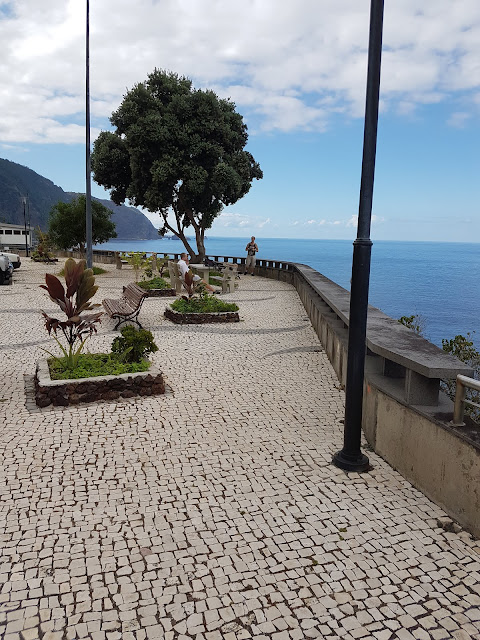Two Stops in The Course of Our Drive to Porto Moniz
 |
| The Fig.1: On our way to Porto Moniz we encountered on this small summer resort. Madeira, on October 2016. Obr.1: Cestou do Porto Moniz jsme narazili na tohle malé letovisko. Madeira 2016. |
On our way to the place in the title of this post we stopped for two times to take a rest out of the car or to enjoy some beautiful views of both the coastline and the sea for a longer time. We had a lot of time to do it. To explore Madeira as better as possible was our goal.
This stop was in front of a small town or a summer resort. We had a beautiful view of it from our resting place. The place was clean and neat. It was decorated with flowers in stony pots and it was equipped with benches to sit.
Then we passed through the summer resort and Vendy stopped behind it. I could photograph a local church. The road led higher above the sea and we did not step down to it. The views of the sea and steep cliffs falling down to it were enough to us. My attention attracted strange fruits of a plant in the parking lot. The plant was cultivated in a stony pot. I could not identify it in the place. Therefore I took several more detailed shots of its leaves and fruits to have good material for a later determination of the plant at my home background. I was lucky because I found its several flowers, too. When you try to identify a plant flowers are one of the most important signs. Mostly, if a plant is in fruit it does not flower and vice versa. Fortunately my plant showed both fruits and flowers.
Only today (7.27. 2017) I have identified the small bush at last. Its names in English are: the Balloon plant or the Balloon cotton-bush, the Bishop´s balls, the Nail head or the Swan plant. Its Latin name is Gomphocarpus physocarpus (Asclepias physocarpa is its older name). Botanists place it into Apocynaceae the family and Asclepiadoideae the subfamily. It comes from the South East Africa.
I could not find it in my botanic literature. Therefore I tried to search for it on the Internet. First I searched for it in Solanaceae the family and Cucurbitaceae the family but these attempts were good for nothing. When I gave the phrase "tropical and subtropical bushes, photos" to the Google´s explorer within a moment I looked at my plant.
The Czech Version
Dvě zastávky během jízdy do Porto Moniz
Tahle zastávka byla před jedním městečkem či letoviskem. Z odpočívadla na něj byl krásný výhled. Místo bylo čisté a upravené. Zdobily ho květiny v kamenných květináčích a bylo vybaveno lavičkami na sezení.
 |
| The Fig.8: One fruit of the small bush unknown to me at the closer view. Madeira, on October, 2016. Obr.8: Jeden plod mně neznámého keříku v bližším pohledu. Madeira, říjen 2016. |
Jeho jméno nevím. Bylo to jen městečko na cestě. Nicméně na mých fotkách zůstalo, protože se mi líbilo jeho komplikované a schodovité uspořádání v kosém lávovitém terénu spadajícím až k moři, kde jsem mohl vidět různá umělá mola využívající přirozené lávové útesy a také malou černou pláž. Neviděl jsem ani velká ani malá plavidla, třebaže mola naznačovala, že by snad dokázala přijmout větší zaoceánskou loď. Myslím, že pro proplouvající lodě to mohla být jakási krátká dočasná zastávka. Na černé pláži byli lidé. Někteří polehávali na černém povrchu a opalovali se, někteří se koupali. V říjnu to byl poslední zbytek nestriktnějších fandů tohoto rekreačního způsobu, protože hlavní sezóna už skončila.
Poté jsme letoviskem projeli a Venda zastavil za ním. Mohl jsem si vyfotit místní kostel. Silnice vedla výš nad mořem a my k němu nesestoupili. Výhledy na moře a strmé srázy, které k němu spadaly nám stačily. Mou pozornost upoutaly zvláštní plody rostliny na parkovišti. Proto jsem udělal několik snímků jejích listů a plodů, abych měl dobrý materiál pro pozdější určení rostliny v domácím zázemí. Měl jsem štěstí, protože jsem našel také několik jejích květů. Když se pokoušíte určit nějakou rostlinu, květy jsou jedním z nejdůležitějších znaků. Většinou, je-li rostlina v plodu, nekvete a naopak. Má rostlina naštěstí ukazovala plody i květy.
 |
| The Fig.11: A view at the direction of our following way from the parking lot. Madeira, on October 2016. Obr.11: Pohled ve směru naší následující cesty z parkoviště. Madeira, říjen 2016. |
Teprve dnes (27.7. 2017 jsem ten keřík konečně určil. Jeho latinský název je Gomphocarpus physocarpus (starší, synonymum je Asclepias physocarpa). Botanici ho řadí do čeledi toješťovitých (Apocynaceae) a podčeledi Asclepiadiodeae. Pochází z JV Afriky. V botanické literatuře jsem ho najít nedokázal. Proto jsem po něm zkusil pátrat na Internetu. Nejdřív jsem ho hledal v čeledi lilkovitých (Solanaceae) a tykvovitých (Cucurbitaceae) a tyhle pokusy byly dobré k ničemu. Když jsem do vyhledávače Google zadal větu "tropické a subtropické keře, fotky" během chvíle jsem se díval na svou rostlinu.
























































